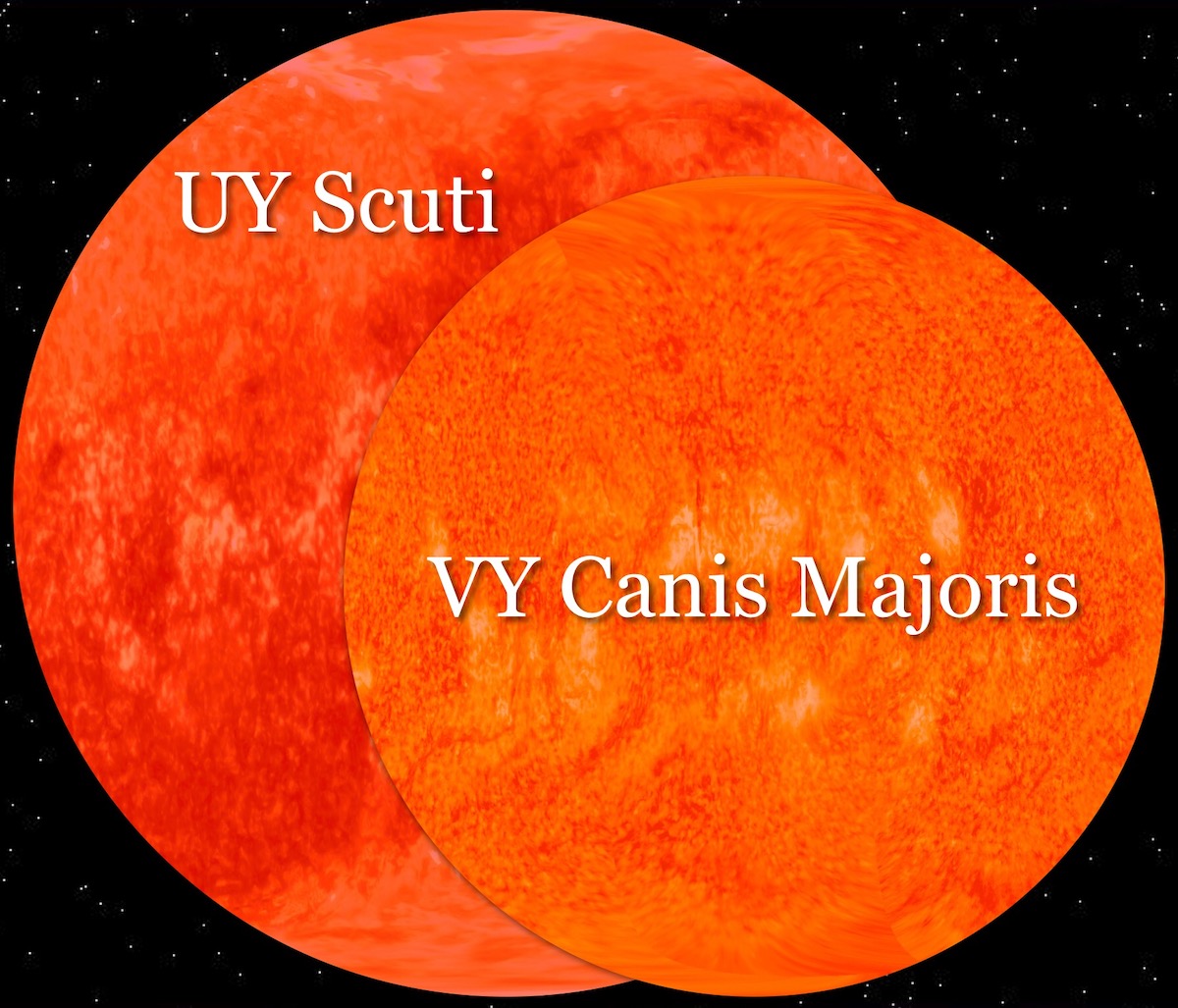Supergiants are the largest and brightest stars in the universe. These massive stellar giants are 10 to 70 times more massive than our sun and shine with a brilliance that outshines entire galaxies. Despite their grandeur, supergiants have very short lifespans compared to other stars, lasting only a few million years before exploding in a cataclysmic supernova.
Characteristics of Supergiants
Supergiants are classified based on their spectral type, luminosity, and temperature. They are typically found in the upper right quadrant of the Hertzsprung-Russell diagram, where they occupy a small region above the main sequence of stars. They are further classified into different types based on their spectra, including O-type, B-type, and A-type supergiants.
O-type supergiants are the most massive and luminous, with a surface temperature of around 30,000 Kelvin. They are also the shortest-lived, with lifetimes of only a few million years. B-type supergiants have a surface temperature of around 15,000 Kelvin, while A-type supergiants have a temperature of around 9,000 Kelvin.
Supergiants have radii that are hundreds of times larger than the sun, and they can have a mass that is up to 70 times greater than the sun. Due to their massive size, supergiants are incredibly bright and are responsible for producing most of the heavy elements in the universe through nuclear fusion reactions.
Life Cycles of Supergiants
Supergiants are born from massive clouds of gas and dust, known as nebulae. The intense gravitational forces within the nebula cause the gas and dust to condense into a protostar, which continues to grow by accreting additional material.
As the protostar grows, its core becomes hotter and denser, eventually reaching temperatures of around 15 million Kelvin. At this point, nuclear fusion reactions begin in the core, converting hydrogen into helium and releasing vast amounts of energy in the form of light and heat.
Supergiants burn through their fuel much faster than other stars due to their immense size and luminosity. They are able to fuse heavier elements at a much faster rate, leading to the production of elements such as carbon, nitrogen, and oxygen. However, this also leads to a shorter lifespan for supergiants, which can end in a catastrophic supernova explosion.
When a supergiant runs out of fuel, its core collapses under the force of gravity, causing the outer layers to explode in a supernova. The explosion can be so bright that it outshines entire galaxies, and it can produce elements as heavy as iron and nickel. The remains of the explosion can form neutron stars or black holes, which can continue to influence the evolution of galaxies for billions of years.
Importance of Supergiants in the Universe
Supergiants play a crucial role in the evolution of galaxies and the universe as a whole. They are responsible for producing most of the heavy elements in the universe, which are essential for the formation of planets, and the evolution of life. These elements are also used in the production of advanced technologies, including semiconductors, batteries, and solar panels.
Supergiants also influence the evolution of galaxies by shaping their structure and dynamics. The intense radiation and winds produced by supergiants can ionize gas clouds and trigger the formation of new stars. The remnants of supernova explosions can also trigger the formation of new stars by compressing gas
Do all stars become Supergiants?
Not all stars become supergiants. Supergiants are a specific type of star that is very massive and luminous, with a short lifespan compared to other types of stars.
The majority of stars in the universe are much smaller and less massive than supergiants, and they follow a different evolutionary path. For example, stars like our sun are classified as main-sequence stars, which are in a stable state of nuclear fusion, converting hydrogen into helium.
As a main-sequence star exhausts its fuel, it begins to evolve into a red giant, a phase in which the star swells to many times its original size, and its surface cools down. Red giants are not as massive or luminous as supergiants, and they have a longer lifespan.
Only the most massive stars, those with at least 10 times the mass of our sun, have the potential to become supergiants. These stars have a shorter lifespan due to their high mass, which causes them to burn through their fuel much faster. As a result, they evolve into supergiants before eventually exploding in a supernova.
So, while supergiants are fascinating and important stars in the universe, they are not a stage that all stars go through. Only a small fraction of stars have the potential to become supergiants, making them a rare and valuable object of study for astronomers.
Types of Supergiant
There are several types of supergiants, which are classified based on their spectral type, luminosity, and temperature. Some of the most commonly recognized types of supergiants include:
- O-type Supergiants: These are the most massive and luminous supergiants, with surface temperatures of around 30,000 Kelvin. They are blue-white in colour and have a radius that can be up to 1,000 times larger than the sun. O-type supergiants are short-lived, with a lifespan of only a few million years, and are known to produce powerful stellar winds and intense radiation.
- B-type Supergiants: B-type supergiants have a surface temperature of around 15,000 Kelvin, and they are less massive and luminous than O-type supergiants. They are also shorter-lived, with a lifespan of only a few tens of millions of years. B-type supergiants are characterised by their blue-white colour and their radius, which can be up to 100 times larger than the sun.
- A-type Supergiants: A-type supergiants have a surface temperature of around 9,000 Kelvin, and they are less massive and luminous than O and B-type supergiants. They are characterised by their yellow-white colour and their radius, which can be up to 20 times larger than the sun. A-type supergiants have a longer lifespan than O and B-type supergiants, lasting up to a few hundred million years.
- Red Supergiants: Red supergiants are a type of supergiant that has evolved beyond the main sequence of stars and is nearing the end of its life cycle. They are characterised by their red colour, and they have a radius that can be up to 1,000 times larger than the sun. Red supergiants are less massive and luminous than O and B-type supergiants, and they have a longer lifespan, lasting up to a few tens of millions of years.
Overall, there are several types of supergiants, each with unique characteristics and lifecycles. Despite their short lifespans, supergiants play a crucial role in the evolution of the universe, shaping the structure and dynamics of galaxies and producing most of the heavy elements in the universe.
Will our Sun become a Supergiant
Yes, our sun will eventually evolve into a type of star known as a red giant, which is a type of star that swells to many times its original size and becomes much cooler. However, it is not massive enough to become a supergiant.
The sun is currently in a stable state of nuclear fusion, converting hydrogen into helium in its core. However, as the sun exhausts its fuel, it will begin to evolve into a red giant, a phase in which the star will expand to many times its original size, eventually reaching a radius that extends beyond the orbit of Venus.
During this phase, the sun will not be classified as a supergiant because it does not have enough mass to undergo the complex and explosive processes that characterise supergiant stars. Instead, the sun will continue to burn through its fuel, fusing helium into heavier elements until it eventually runs out of fuel and evolves into a white dwarf.
The process of the sun evolving into a red giant is estimated to take around 5 billion years, which means that we still have plenty of time before this phase occurs. Nonetheless, the study of supergiants is important for understanding the evolution of stars and the universe as a whole, and it offers insight into the processes that govern the cosmos.
Examples of Supergiants
There are several well-known examples of supergiants, some of which are visible to the naked eye. Here are a few examples:
Betelgeuse
Betelgeuse is a red supergiant located in the constellation Orion, about 640 light-years away from Earth. It is one of the largest and brightest stars in the night sky and has a diameter estimated to be around 1,000 times that of the sun. Betelgeuse is also a variable star, meaning that its brightness fluctuates over time.
Rigel
Rigel is a blue supergiant located in the same constellation as Betelgeuse. It is one of the brightest stars in the sky, with a luminosity estimated to be around 120,000 times that of the sun. Rigel has a diameter estimated to be around 78 times that of the sun and is located about 860 light-years away from Earth.
Antares
Antares is a red supergiant located in the constellation Scorpius, about 550 light-years away from Earth. It is one of the brightest stars in the sky and has a diameter estimated to be around 800 times that of the sun. Antares is also a variable star, with its brightness fluctuating over time.
Deneb
Deneb is a blue supergiant located in the constellation Cygnus, about 2,600 light-years away from Earth. It is one of the largest and most luminous stars known, with a diameter estimated to be around 200 times that of the sun and a luminosity estimated to be around 200,000 times that of the sun.
Overall, these are just a few examples of the many supergiants that exist in the universe. These massive and brilliant stars play a crucial role in the evolution of galaxies and the universe as a whole, and their study offers important insights into the nature of the cosmos.

